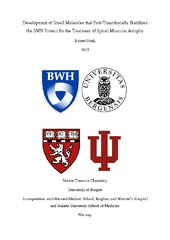Development of Small Molecules that Post-Transitionally Stabilizes the SMN Protein for the Treatment of Spinal Muscular Atrophy
Master thesis

View/
Date
2019-08-31Metadata
Show full item recordCollections
- Department of Chemistry [442]
Abstract
Spinal Muscular Atrophy is an autosomal recessive neurodegenerative disorder, caused by the lack of SMN genes. Previous work done by Laboratory for Drug Discovery in Neurodegeneration (LDDN) at Brigham and Women’s Hospital optimized a lead compound from screening of 115,000 compounds for treatment of SMA. With the substantial amount of medical drugs involving imidazole as a component, this work focuses on the synthesis of analogs where the heterocycle in the lead compound is exchanged with imidazole. The synthesis of 3-chloro-4-fluoro-N-(2-(1-hydroxycyclobutyl)-1-methyl-1H-imidazol-4-yl)benzamide was attempted by several different routes. The first involved attaching a ketone by lithiation of the central methylated imidazole carbon. Five different methods of nitration were used thereafter, in an attempt to nitrate the 4-position on the heterocycle. Although results were promising from one of the nitrations, the product could not be isolated and larger scale repetition of the reaction yielded no product. The second route involved methylation of 4(5)-nitroimidazole, followed by a reduction. The resulting amine was collected in high yield but deteriorated over time. Three different protective groups were attempted, but all reactions were plagued by low or no yield. Despite this, the BOC protected amine was attempted lithiated, but the notoriously low yield of lithiations made the route unsustainable. Using formic acid, the amine was amide protected, but the resulting compound proved insoluble in common solvents used for n-BuLi. The amine was instead amidated resulting in 3-chloro-4-fluoro-N-(1-methyl-1H-imidazol-4-yl)-benzamide in sufficient yield. The compound was lithiated successfully. However, it was directed to the backbone, resulting in a different analog of the target molecule. In an attempt to direct the lithiation, 1-methyl-4-nitro-1H-imidazol was brominated. The resulting compound gave poor results in both a Grignard reaction, and with n-BuLi. Reduction of the nitro group with Pd(OH)2/C and by iron also failed. Methyl 1-methyl-1H-imidazole-4-carboxylate also was attempted to be lithiated, but with no success. The analog of the target molecule was sent, together with its precursor, for testing in the SMA assay. Both compounds proved inactive.